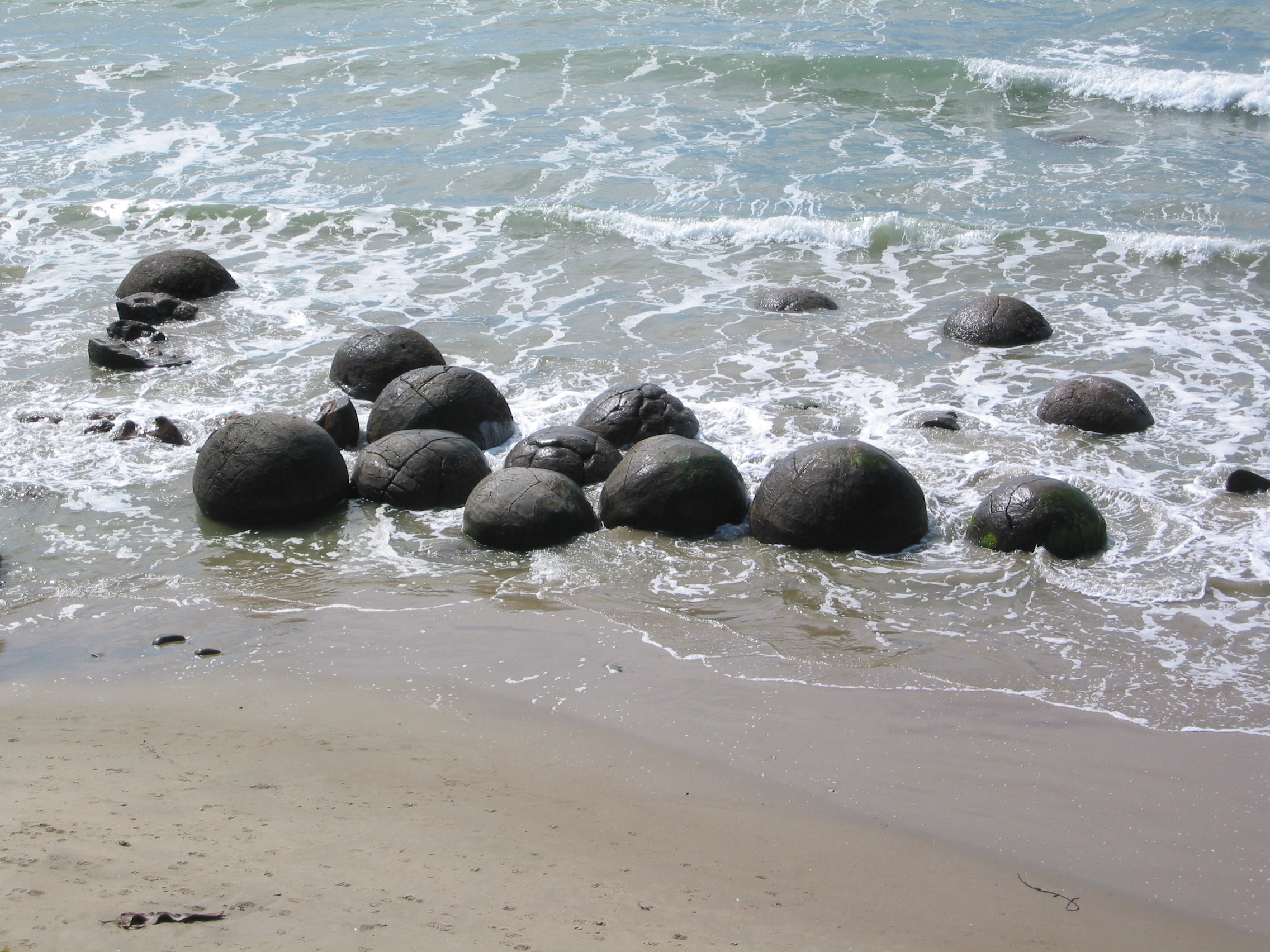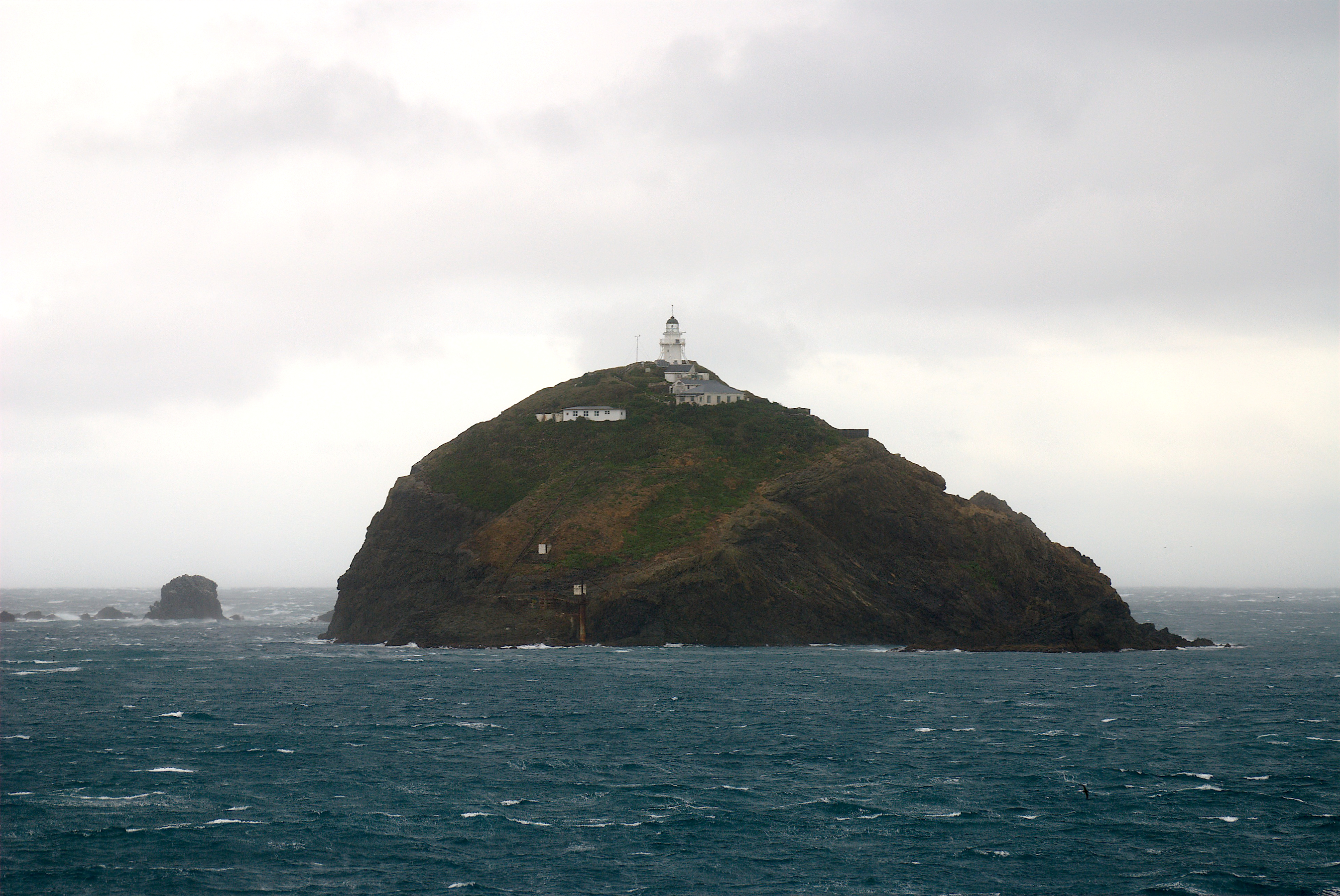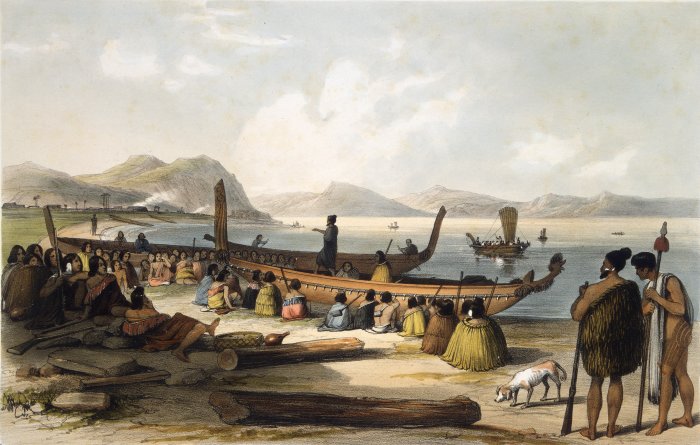|
Kātiki Point Lighthouse
The Kātiki Point Lighthouse, also known as Moeraki Lighthouse, shone for the first time in 1878, following several accidents on the dangerous reefs around the area, to make the area safer for ships that sailed past on their way to Port Chalmers, Dunedin. The lighthouse was built between the settlements of Moeraki and Kātiki, on the tip of the Moeraki Peninsula, which is known as Katiki Point, Kātiki Point or Moeraki Point. History The point has a long history of wrecks, notably the wrecking of the ancestral Waka (canoe), waka atua on a return trip from Hawaiki, leaving some of the cargo being on the beach at Kātiki, below the lighthouse. Tradition holds that the remains of the cargo are the Moeraki Boulders. Just before the light was to be lit for the first time, a storm shook the tower to the extent that the lamp glass broke. A new one had to be ordered, and the tower was strengthened, before the light was lit on 22 April 1878. The wooden tower stands high and above se ... [...More Info...] [...Related Items...] OR: [Wikipedia] [Google] [Baidu] |
South Island
The South Island ( , 'the waters of Pounamu, Greenstone') is the largest of the three major islands of New Zealand by surface area, the others being the smaller but more populous North Island and Stewart Island. It is bordered to the north by Cook Strait, to the west by the Tasman Sea, to the south by the Foveaux Strait and Southern Ocean, and to the east by the Pacific Ocean. The South Island covers , making it the List of islands by area, world's 12th-largest island, constituting 56% of New Zealand's land area. At low altitudes, it has an oceanic climate. The most populous cities are Christchurch, Dunedin, Nelson, New Zealand, Nelson and Invercargill. Prior to European settlement, Te Waipounamu was sparsely populated by three major iwi – Kāi Tahu, Kāti Māmoe, and the historical Waitaha (South Island iwi), Waitaha – with major settlements including in Kaiapoi Pā near modern-day Christchurch. During the Musket Wars expanding iwi colonised Te Tau Ihu Māori, Te Tau Ihu, ... [...More Info...] [...Related Items...] OR: [Wikipedia] [Google] [Baidu] |
Moeraki Boulders
The Moeraki Boulders (officially Moeraki Boulders / Kaihinaki) are unusually large spherical boulders lying along a stretch of Koekohe Beach on the wave-cut Otago coast of New Zealand between Moeraki and Hampden. They occur scattered either as isolated or clusters of boulders within a stretch of beach where they have been protected in a scientific reserve. These boulders are grey-coloured septarian concretions, which have been exhumed from the mudstone and bedrock enclosing them and concentrated on the beach by coastal erosion.Boles, J. R., C. A. Landis, and P. Dale, 1985''The Moeraki Boulders; anatomy of some septarian concretions'' Journal of Sedimentary Petrology, vol. 55, n. 3, p. 398-406.Fordyce, E., and P. Maxwell, 2003, ''Canterbury Basin Paleontology and Stratigraphy, Geological Society of New Zealand Annual Field Conference 2003 Field Trip 8'', Miscellaneous Publication 116B, Geological Society of New Zealand, Dunedin, New Zealand. Forsyth, P.J., and G. Coates, 1992, ... [...More Info...] [...Related Items...] OR: [Wikipedia] [Google] [Baidu] |
Buildings And Structures In Otago
A building or edifice is an enclosed structure with a roof, walls and windows, usually standing permanently in one place, such as a house or factory. Buildings come in a variety of sizes, shapes, and functions, and have been adapted throughout history for numerous factors, from building materials available, to weather conditions, land prices, ground conditions, specific uses, prestige, and aesthetic reasons. To better understand the concept, see ''Nonbuilding structure'' for contrast. Buildings serve several societal needs – occupancy, primarily as shelter from weather, security, living space, privacy, to store belongings, and to comfortably live and work. A building as a shelter represents a physical separation of the human habitat (a place of comfort and safety) from the ''outside'' (a place that may be harsh and harmful at times). buildings have been objects or canvasses of much artistic expression. In recent years, interest in sustainable planning and building practi ... [...More Info...] [...Related Items...] OR: [Wikipedia] [Google] [Baidu] |
Lighthouses In New Zealand
This is a list of lighthouses in New Zealand. Maritime New Zealand operates and maintains 23 active lighthouses and 74 Beacon#For navigation, light beacons. All of these lighthouses are fully automated and controlled by a central control room in Wellington. Other lights, such as the Taiaroa Head and Bean Rock Lighthouse, Bean Rock lighthouses, are operated by local port authorities. There are also several decommissioned lighthouses not listed below, including the Manukau Heads Lighthouse, Manukau South Head, Boulder Bank, and Akaroa lighthouses. Many of New Zealand's earliest lighthouses were designed by marine engineer James Balfour (engineer), James Balfour and his successor John Blackett (engineer), John Blackett. The New Zealand Nautical Almanac lists all of New Zealand's active lighthouses and lights, along with their locations, characteristics and ranges. North Island South Island See also * Lists of lighthouses and lightvessels References External li ... [...More Info...] [...Related Items...] OR: [Wikipedia] [Google] [Baidu] |
Lighthouses Completed In 1878
A lighthouse is a tower, building, or other type of physical structure designed to emit light from a system of lamps and lenses and to serve as a beacon for navigational aid for maritime pilots at sea or on inland waterways. Lighthouses mark dangerous coastlines, hazardous shoals, reefs, rocks, and safe entries to harbors; they also assist in aerial navigation. Once widely used, the number of operational lighthouses has declined due to the expense of maintenance and the advent of much cheaper, more sophisticated, and more effective electronic navigational systems. History Ancient lighthouses Before the development of clearly defined ports, mariners were guided by fires built on hilltops. Since elevating the fire would improve visibility, placing the fire on a platform became a practice that led to the development of the lighthouse. In antiquity, the lighthouse functioned more as an entrance marker to ports than as a warning signal for reefs and promontories, unlike many moder ... [...More Info...] [...Related Items...] OR: [Wikipedia] [Google] [Baidu] |
List Of Lighthouses In New Zealand
This is a list of lighthouses in New Zealand. Maritime New Zealand operates and maintains 23 active lighthouses and 74 light beacons. All of these lighthouses are fully automated and controlled by a central control room in Wellington. Other lights, such as the Taiaroa Head and Bean Rock lighthouses, are operated by local port authorities. There are also several decommissioned lighthouses not listed below, including the Manukau South Head, Boulder Bank, and Akaroa lighthouses. Many of New Zealand's earliest lighthouses were designed by marine engineer James Balfour and his successor John Blackett. The New Zealand Nautical Almanac lists all of New Zealand's active lighthouses and lights, along with their locations, characteristics and ranges. North Island South Island See also * Lists of lighthouses and lightvessels References External links * * {{Oceania topic, List of lighthouses in * New Zealand Lighthouses Lighthouses A lighthouse is a ... [...More Info...] [...Related Items...] OR: [Wikipedia] [Google] [Baidu] |
Wellington
Wellington is the capital city of New Zealand. It is located at the south-western tip of the North Island, between Cook Strait and the Remutaka Range. Wellington is the third-largest city in New Zealand (second largest in the North Island), and is the administrative centre of the Wellington Region. It is the world's southernmost capital of a sovereign state. Wellington features a temperate maritime climate, and is the world's windiest city by average wind speed. Māori oral tradition tells that Kupe discovered and explored the region in about the 10th century. The area was initially settled by Māori iwi such as Rangitāne and Muaūpoko. The disruptions of the Musket Wars led to them being overwhelmed by northern iwi such as Te Āti Awa by the early 19th century. Wellington's current form was originally designed by Captain William Mein Smith, the first Surveyor General for Edward Wakefield's New Zealand Company, in 1840. Smith's plan included a series of inter ... [...More Info...] [...Related Items...] OR: [Wikipedia] [Google] [Baidu] |
Maritime New Zealand
Maritime New Zealand (New Zealand Maritime Safety Authority) is a Crown entity and also a state maritime safety authority responsible for protecting the maritime transport sequence and marine environment within New Zealand and maintaining safety and security. They define their vision as: "a maritime environment with minimum deaths, accidents, incidents and pollution as part of an integrated and sustainable transport system". Maritime New Zealand supports people by providing guidance and advice about Seafarer Certifications as well. History A maritime authority called the Marine Board was originally established in 1862 and controlled by the Customs Department until near the end of the nineteenth century, when it was renamed the Marine Department. In 1907, the Marine Department acquired the 805 ton Royal Navy gun boat HMS ''Sparrow''. This was converted into a training ship and renamed NZS ''Amokura''. Over the next 14 years 527 boys trained in ''Amokura'', 25 of them going ... [...More Info...] [...Related Items...] OR: [Wikipedia] [Google] [Baidu] |
Hawaiki
(also rendered as in the Cook Islands, Hawaiki in Māori, in Samoan, in Tahitian, in Hawaiian) is, in Polynesian folklore, the original home of the Polynesians, before dispersal across Polynesia. It also features as the underworld in many Māori stories. Anne Salmond states ''Havaii'' is the old name for Raiatea, the homeland of the Māori. When British explorer James Cook first sighted New Zealand in 1769, he had on board Tupaia, a Raiatean navigator and priest. Cook's arrival seemed to be a confirmation of a prophecy by Toiroa, a priest from Māhia. At Tolaga Bay, Tupaia conversed with the ''tohunga'' associated with the school of learning located there, called Te Rawheoro. The priest asked about the Māori homelands, 'Rangiatea' (Ra'iatea), 'Hawaiki' (Havai'i, the ancient name for Ra'iatea), and 'Tawhiti' (Tahiti). Etymology Linguists have reconstructed the term to Proto- Nuclear Polynesian ''*sawaiki''. The Māori word figures in traditions about the ar ... [...More Info...] [...Related Items...] OR: [Wikipedia] [Google] [Baidu] |
New Zealand
New Zealand () is an island country in the southwestern Pacific Ocean. It consists of two main landmasses—the North Island () and the South Island ()—and List of islands of New Zealand, over 600 smaller islands. It is the List of island countries, sixth-largest island country by area and lies east of Australia across the Tasman Sea and south of the islands of New Caledonia, Fiji, and Tonga. The Geography of New Zealand, country's varied topography and sharp mountain peaks, including the Southern Alps (), owe much to tectonic uplift and volcanic eruptions. Capital of New Zealand, New Zealand's capital city is Wellington, and its most populous city is Auckland. The islands of New Zealand were the last large habitable land to be settled by humans. Between about 1280 and 1350, Polynesians began to settle in the islands and subsequently developed a distinctive Māori culture. In 1642, the Dutch explorer Abel Tasman became the first European to sight and record New Zealand. ... [...More Info...] [...Related Items...] OR: [Wikipedia] [Google] [Baidu] |
Waka (canoe)
Waka () are Māori people, Māori watercraft, usually canoes ranging in size from small, unornamented canoes (''waka tīwai'') used for fishing and river travel to large, decorated war canoes (''waka taua'') up to long. The earliest remains of a canoe in New Zealand were found near the Anaweka River, Anaweka estuary in a remote part of the Tasman District and Radiocarbon dating, radiocarbon-dated to about 1400. The canoe was constructed in New Zealand, but was a sophisticated canoe, compatible with the style of other Polynesian voyaging canoes at that time. Since the 1970s, about eight large double-hulled canoes of about 20 metres have been constructed for oceanic voyaging to other parts of the Pacific Ocean, Pacific. They are made of a blend of modern and traditional materials, incorporating features from ancient Melanesia, as well as Polynesia. Waka taua (war canoes) ''Waka taua'' (in Māori language, Māori, ''waka'' means "canoe" and ''taua'' means "army" or "war party") a ... [...More Info...] [...Related Items...] OR: [Wikipedia] [Google] [Baidu] |






